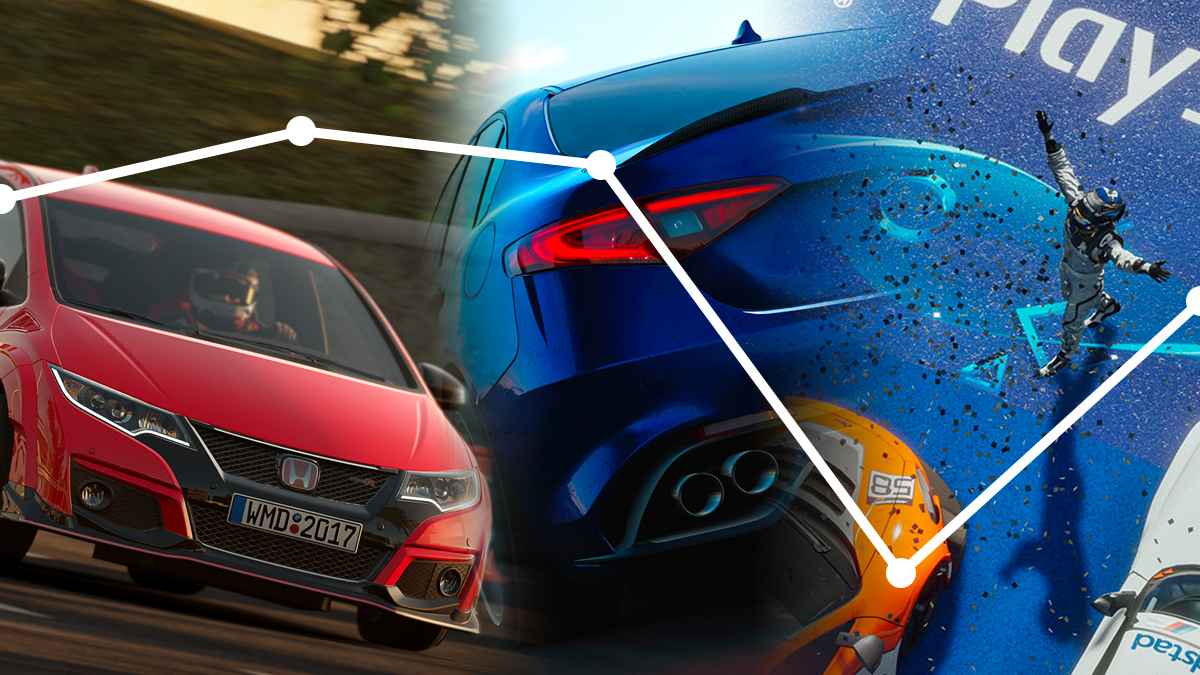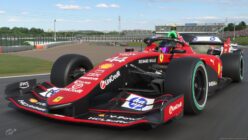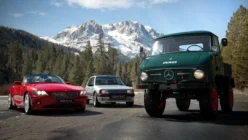Disclaimer: Although we’ve striven to ensure accuracy, using multiple sources, any data regarding sales in this article should be treated as our estimates only.
It might not seem like it, but console sim-racing is having a bit of a hard time of it right now.
While the breadth of choice is undoubtedly the strongest it has ever been, regardless of preferences, the sector’s popularity is waning. There’s more titles on the shelves than ever, but it seems that they’re not moving as consumers pass them by.
In fact, according to our estimates, 2016 was one of the worst years on record for racing games across the major titles. Despite six major racing game franchises, by our estimates the combined titles sold fewer console copies than in any year this century.
Discounting the more story-driven Need for Speed titles, there are only five slower years in the entire history of the PlayStation and Xbox console families. To put this in context, the first Gran Turismo title sold more copies in its first year than all titles put together did in 2016:
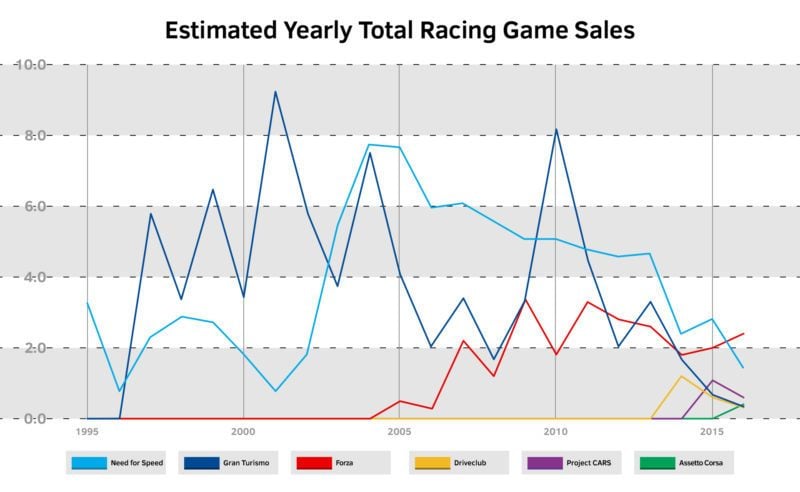
So what’s going on, and how will the glut of great racing titles released this Fall reverse it?
Accessibility Over All-Out Authenticity
With 75 million sales of Gran Turismo, it’s easy to lose focus on the fact that racing games are a niche product. That said, the first Gran Turismo and its sequel were ludicrously popular.
The games focused on a mix of realism and accessibility. Though they deviated from ordinary racing games by a requirement to use the brakes to slow down, they were not slavish in regards to copying real life.
Modern racing games major on realism. It’s all about the physics calculations, the laser-scanned tracks and the perfect vehicle replication. Whereas in 1998 you could spend $60 on a racing game, they began to all but require a steering wheel controller. That’s a $300 commitment, and that’s going to put many ordinary and young gamers off.
There’s 90 million PS4 and XB1 consoles out there, but only a few percent of those have a steering wheel to go along with them. If you need a steering wheel to play the game, you cut out a massive chunk of the potential market.
The good news is that the three big racing game releases this year all seem to be a step back from this brink. While best enjoyed with a steering wheel, all are perfectly playable with regular controllers too. But then if you can drive a real car with a controller, why shouldn’t they be?
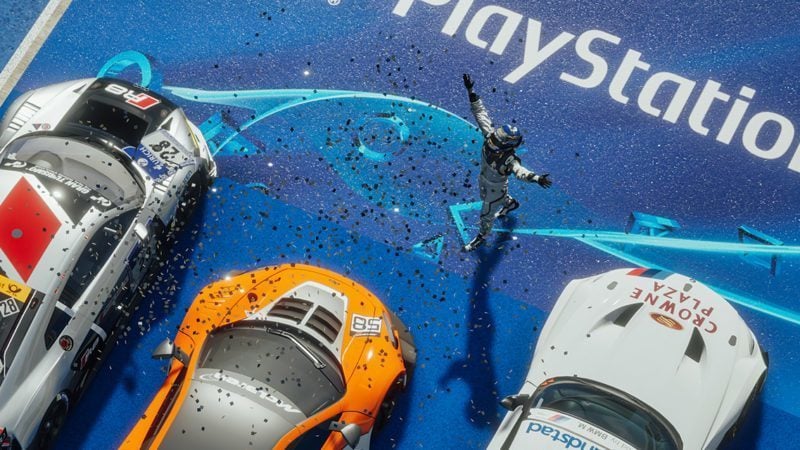
More Focus on the Racers, Not Just the Winner
In racing it’s all about finishing first. As one famous fictional racer put it, it doesn’t matter whether you win by an inch or a mile, winning’s winning. In racing games the winner gets the prize and recognition while everyone else is a loser.
This can result in a lot of participants becoming disheartened, as they have no way to win, and quitting. Worse, it can foster the ugly “win at all costs” mindset, and all the driving manners that entails. This drives even more people away.
Other games recognize the individual player by a “micro-reward” system. Take an online shooting game. If you kill another player, your name goes on the screen. Kill them in a special way and you get a special icon, to amaze everyone. Kill ten with a throwing knife? In-game upgrade. Kill a hundred guys with a throwing knife? Bigger upgrade.
Make the challenges just slightly less difficult than the reward for doing them and people will keep plugging away — like substance addiction — all for a gold skin for their sniper rifle.
Such mechanisms are rarely seen in racers. After all, flagging every overtake on the screen, could become irritating.
The Forza franchise experimented with a sort of “micro-reward” system back in FM4, where players received extra credits based on the number (and quality) of “race feats” performed on track. Pass a car cleanly but very closely? Extra credits. Held onto a draft for the entire straight? Extra credits. Feats still exist in FM7, but they only provide credits when paired off with appropriate Mod Cards these days.
Meanwhile, GT Sport has introduced a system which rewards the player for a number of different in-game actions: fuel used; liveries liked; time spent on track; credits spent. They may not be feted during the action, but it resembles a micro-reward system at its core. These milestones may only be one-time affairs, but they still give players more approachable goals outside of simply winning.
One thing we do see in the game is your Sportsmanship Rating (SR) progress at each sector marker. Run a clean sector and you get an SR boost (in green), make contact with something or run off track and it goes down (in orange). In the post-race screen we can see the effects of each driver’s on-track antics too, with red and blue icons denoting a decrease or increase in SR.
You can see a similar system in Project CARS 2, with its Competitive Racing License. Experience Point and level systems are also present in both GT Sport and Forza Motorsport 7, so players in all three of the major titles have a way to track progress beyond just being first across the line.
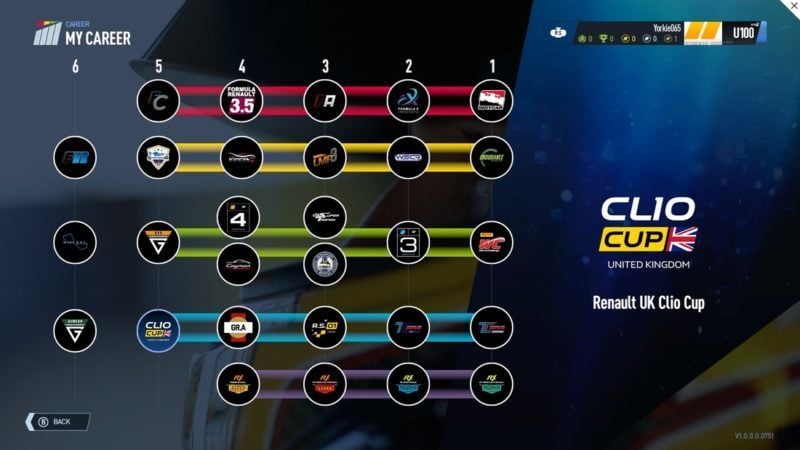
Diversified Product Offerings
Gran Turismo was a new idea in 1997, and like any new idea, if it’s good it’s worth replicating. The net result was that all racing games took on the essence of Gran Turismo.
That meant a huge list of real-life cars which you could tune and modify. You’d need somewhere to race them, so you got a large list of real-life circuits (and some fictional homages) too. Bolt on a career progression system so you moved from cheap, slow cars and unlocked the ending movie after the fastest race series and you had a racing game.
But for 2017 our major titles all take a different tack from one another, and avoid treading on each other’s toes.
Forza Motorsport 7 still majors on the car collection angle. Hundreds of cars from the real world, dozens of circuits and plenty of tuning options keeps the traditionalists happy. Project CARS 2, like its predecessor, is more of a racing career simulator. You start off at whatever level you wish and progress up the tiers through your successes, much as a real racing driver would.
GT Sport’s controversial and radical overhaul may have done it and the other games a huge favor, despite its mixed reception. By shifting focus to esports, Gran Turismo has once again found a unique selling point. It still has a car and track list based on a faithful recreation of reality (or near equivalent) but it’s small and tightly focused around online competition.
Each game now offers something clearly different from the others, giving gamers a reason to buy all three.

Nothing at All, It’s Just Natural Sales Cycles
There’s certainly a case to be made here for the slump just being down to gaps in game releases and trends in the industry as a whole.
The spaces between major releases tally with fallow years. Even including Need for Speed’s relentless annual refresh, any year before 2005 that contained the launch of a Gran Turismo title saw a significant increase. Any year that didn’t was down.
A year like 2007, that saw both a GT release and an FM release, had sales up by 30%, with a fall the following year with no major release down by 40%.
2016 was a perfect storm. With no GT, no Forza Motorsport, no Need for Speed title, Driveclub at two years old and Project CARS a year in, 2016 had no major racing titles on eighth generation hardware, save for the open-world Forza Horizon 3.
For 2017 we see the exact opposite picture. The three major titles are already out, and there’s even a new Need for Speed too. But will it be enough to halt the decline, and what happens in 2018 when there are no new releases?
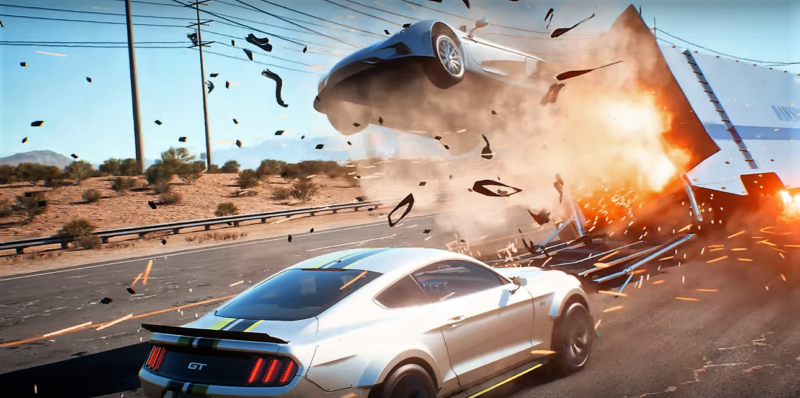
Gaming has been moving through a worrying time recently. Global console sales are down to about a third of what they were a decade ago, shrinking every year. Only the PS4, which is on track to be the best-selling Sony console ever, is bucking the trend. Physical game sales are falling year on year too, although digital downloads and mobile game sales are rising.
Perhaps then the time has gone where a GT game can sell 10 million, or a Forza game ships 5 million? Even a major annual release like Call of Duty sold far fewer copies on launch day in 2016 than just five years previously.
But perhaps not; there are some encouraging signs. Each of the three major racing game releases seems to have outperformed their own predecessor at launch. They’re remaining in the top 10 charts around the world too, even in the face of major cross-platform titles like Assassin’s Creed and Call of Duty.
Furthermore, even those huge titles have seen a return from rock bottom. 2017’s Assassin’s Creed Origins has by far out-performed its predecessor, Syndicate, which was the worst-selling game in the series. The same applies to the 2017 Call of Duty release, World War II, which eclipsed the dreadful sales of 2016’s Infinite Warfare.
Only time will tell if the punters return to racing games in numbers, but the future seems better than it has in a while.
See more articles on Sales Figures.

